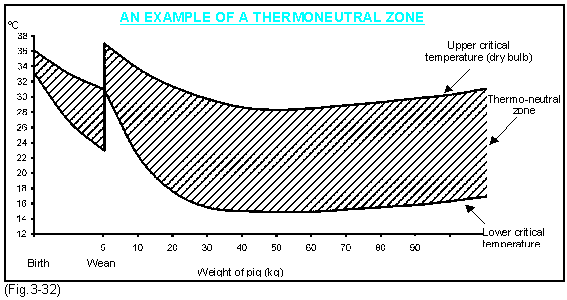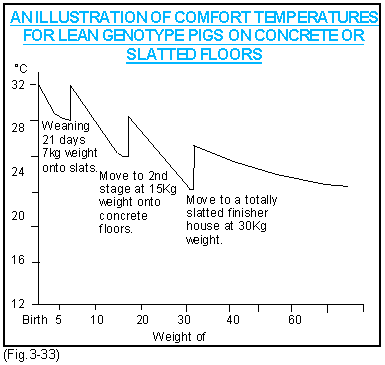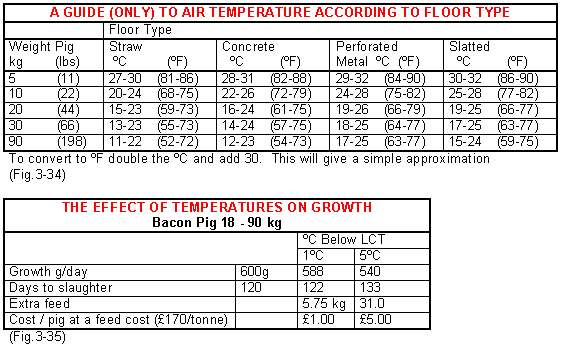



Environmental temperatures
It is important to maintain the pig within an equitable temperature range and this is called the thermo-neutral zone. It is dependent upon the type of floor, its insulation properties, the air speed and temperature and the insulation of the building.
This is particularly so if the pig is at a critical time in relation to disease challenge, or when under environmental stress. For example if it coincides with a move from solid concrete or straw bedded floors to concrete slats. The temperature requirement for the pig might have been 20ºC (68ºF) before the move but could well be 25ºC (77ºF) for the first days in the new accommodation. Pigs that are within their comfort zone will lie on their sides barely touching their neighbours.
The point at which pigs must increase heat production to keep warm is called the lower critical temperature (LCT). Many factors affect this including body weight, feed intake, age, insulation of the building and in particular the floor type. There is an upper critical temperature (UCT) and the range between the upper and lower ones is called the thermo-neutral zone as shown in Fig.3-32.

Fig.3-33 gives guidelines to the temperature requirements necessary at different phases in the production cycle.

Adverse temperatures have effects at the following critical times:
- From birth to 48 hours.
- From 8-14 days of age.
- From weaning to 7 days post-weaning.
- On movement from first to second stage weaner accommodation.
- A change in the type of flooring e.g. solid to slats, bedded to non-bedded.
- A change of housing or nutrition.
- A change in stocking density.
- A move from dry to wet feeding.
- A move to poorly insulated houses.
- Movement into a wet house.
- Fluctuations in external temperatures due to ventilation and air speed.
- Faulty environmental controllers.
- Low energy diets or unpalatable feed.
- Restricted feeding.
- Failure to eat sufficient feed.
- Thin pigs.
- Disease.
- The sow during lactation.
- From weaning to 21 days post-mating.
- In the last six weeks of pregnancy.
Because there are so many variables it is difficult to be categorical about specific temperatures for different weights of pig. Approximate guidelines for different floor types are shown in Fig.3-34 but the ultimate determinant is the pig itself, by its behaviour, lying patterns and performance.

For every degree below the LCT (lower critical temperature) a growing pig looses approximately 10-12g of liveweight gain per day. A level of 1ºC below the LCT during the growing period could cost £1.00 in extra feed per pig. Fig.3-35.
Draughts at any age can result in the pig experiencing significantly lower temperatures than might be registered by an air temperature thermometer. This is the wind chill factor.







